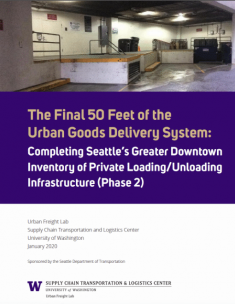Seattle is widely thought to be the first city in the U.S. and the E.U. to comprehensively map the Center City area's commercial vehicle load/unload space network, including its private loading/unloading infrastructure. The data methods in this toolkit were designed and used to create both a GIS map and an inventory of key physical features of all private loading docks, bays and areas for commercial vehicles in Seattle's First Hill and Capitol Hill neighborhoods. The physical, truck-related attributes collected—grouped into location, design and capacity features—directly impact private infrastructure operations.
Because these facilities are generally privately owned and managed, policymakers and stakeholders often lack information about them—information critical to urban planning. By and large, this private infrastructure has been a missing piece of the urban freight management puzzle. The Urban Freight Lab's private infrastructure survey helps complete that puzzle and advance efforts to make urban freight delivery more efficient in increasingly dense, constrained cities, like Seattle. Seattle is thought to be the first city to develop and maintain a database with the location and features of private loading/unloading infrastructure.
This project provides critical foundational data to help cities actively manage their load/unload network to reduce truck circling as drivers search for load/unload space, reduce truck dwell times once drivers find a load/unload space, and reduce carriers' failed first delivery attempts: All this helps make the city's finite load/unload spaces more productive and lessens gridlock.

